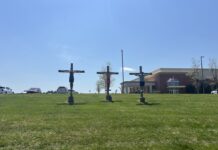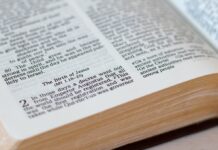
Chapter 9 of Acts of the Apostles is the story of the most dramatic and most famous conversion in history – the conversion of Saul on the road to Damascus. But we cannot take this event in isolation. We need to look back briefly to the martyrdom of Stephen or even further back to the persecution of Peter and John and probably the other disciples as well.
Saul of Tarsus was there in Jerusalem through all of those events. He was there studying under Gamaliel, the leading Jewish theologian of the day. Saul was in a position to witness the Sanhedrin in action. He also witnessed the Apostles in action. He was there during the persecution. And he was a witness to the stoning of Stephen. Indeed Acts 8:1 tells us that Saul was “consenting” to Stephen’s death. It was, after all, the manner of execution prescribed for blasphemy by the Mosaic Law, and Saul was steeped in the Mosaic Law: a Pharisee and zealous for the Law. And, we can be pretty sure that he was familiar with the life and death of Jesus, which was after all, the root of all this hubbub.
So there must have been massive conflict within Saul. Why was the Sanhedrin so adamantly opposed to this handful of radicals? Why not just ignore them like Gamaliel advised? How could these uneducated Jews endure such persecution from the religious leaders and stick to their radical message? How was it that the more they were opposed, the more their message spread? Was it possible that the message of Israel’s most revered prophets was actually coming to pass?
What does one do when confronted with such conflict? You go with the familiar. You stick to what you have been taught. You double down on what you believe to be right. That’s exactly what Saul did. Acts 8:3 tells us, “ But Saul began to destroy the church. Going from house to house, he dragged off men and women and put them in prison.”(NIV). After a brief interlude we pick up the story of Saul again in Acts 9:1 where it says, “Meanwhile, Saul was still breathing out murderous threats against the Lord’s disciples. He went to the High Priest and asked him for letters to the synagogues in Damascus, so that if he found any there who believed in the Way, whether men or women, he might take them as prisoners to Jerusalem.”(NIV).
The next 8 verses of chapter 9 tell us the familiar story of Saul’s encounter with the risen Jesus on the Damascus road. This was not an easy journey. It was about 140 miles from Jerusalem to Damascus and Saul was probably walking. So the trip probably took 6-7 days, and he couldn’t travel on the Sabbath. He also probably had an entourage of soldiers from the temple guard, but he couldn’t socialize with them because he was a Pharisee. Saul was very much alone with nothing to do but walk and think. And when the time was right, and Saul was fully prepared, Jesus came to him in a powerful vision. And Saul surrendered.
That is the universal pattern for becoming a Christian. When the time is right and Jesus calls, you must surrender. For some of us who were fortunate enough to be raised in a Christian home, it was a simple step; a totally natural thing. No grand visions; just a simple altar call on a Sunday night, or at a youth rally or at summer camp, or at a church revival. For others, it may have been, or may still be, a long, hard struggle. But in the end, the formula is always the same. When the time is right and Jesus calls, you surrender. Intellectual assent is a good thing and not to be despised, but it is only through surrender that we can enter into the fellowship of Christ and the presence of God.
Well, Saul’s encounter was pretty dramatic. He fell to the ground, or was knocked to the ground, and when he was able to get up, he was blind. His companions had to help him into the city, where he took refuge in the home of a man named Judas.
Here our story line introduces us to Ananias. We don’t know anything about Ananias except what we can discern from this account. We know he was a disciple, and a willing follower. When Jesus called
him in a vision he responded immediately. No reluctance like Moses; didn’t have to be called three times like Samuel. Just “Yes, Lord”.
Jesus’ message to Ananias was straight forward and plain. Go to a certain place and do a certain thing. But when he heard the message Ananias had some serious concern. I’ve heard about this guy. I know why he’s here. He’s got Carte Blanch from the Sanhedrin and soldiers to back him up. If I go down there I’ll likely be thrown in prison, and maybe my wife and kids too. This is worse than being thrown into the lion’s den. You’re asking me to deliberately walk right into the lion’s den!
Jesus’ response was emphatic: “Go!” This is important. This is immediate. The future of the church hangs in the balance here. Now I have no doubt that if Ananias had refused Jesus’ command, that Jesus would have found another way. God’s plan may be opposed, but can never be defeated. And Ananias was the chosen messenger.
In verse 15 we have Paul’s commission. “This man is my chosen instrument to proclaim my name to the Gentiles and their kings and to the people of Israel.” (NIV) So Ananias goes to the house of Judas on Straight Street in beautiful downtown Damascus and greets Saul as, “Brother, Saul”. I’m pretty sure that there was a lot more dialogue between Paul and Ananias than Luke has recorded. There was probably a retelling of the Damascus road experience and a retelling of the visions that brought them together and probably some discussion about what to do next to respond to this rather open ended commission.
There were, of course, some immediate things to do. It seems to me that there are three distinct steps that take place here:
- First, “flakes fell from Saul’s eyes and he could see again.” This is the last vestiges of his blindness. Yes, it was physical but it was also symbolic of his being able to see clearly God’s plan throughout the Old Testament scriptures that he knew so well. He could “see”, spiritually, as well as physically. He could understand; he could know for certain that Jesus was the fulfillment of Hebrew scripture. And he could accept the Lordship of Jesus under the Fatherhood of God.
- Second, he was baptized. Baptism is the symbolic confirmation of a covenant relationship. Jesus’ baptism confirmed the covenant relationship between Jesus and God the Father. Saul’s baptism confirmed the covenant relationship between Jesus and Saul. Our baptism confirms our covenant relationship between us and God, through Jesus Christ.
- Third, he “ate food and was strengthened”. Saul had not eaten for three days and he needed to be strong to undertake the mission God had for him. One must take care of the body as well as the spirit. Humans are not complete without a body. That is why we believe so strongly in resurrection because a spirit, separated from a body by death, is incomplete.
So Saul, whom we can now call Paul, “spent several days with the disciples in Damascus.”(NIV) We don’t know what happened to Judas, but we notice here that Paul changes houses. He is staying with the disciples, not with the Jews. That is important. We need to move away from people who don’t share our Christian beliefs and associate with those who do. That’s where church comes in. That is how we are all strengthened in our mutual commitments. That is not to say that we should not share the gospel with others because that is our commission. But Psalm 1 says: “Blessed is the man who does not walk in the council of the wicked or stand in the way of sinners or sit in the seat of mockers.” (NIV). In other words you should not be comfortable in your association with wicked people or sinners or those who make light your faith. Move away from them! They will drag you down.
Then, “At once he began to preach in the synagogues that Jesus is the Son of God.” WOW! Talk about walking into the lion’s den! He didn’t waste any time. He got started with his preaching ministry immediately. And he went directly to his fellow Jews who held to his former beliefs. But his message was quite unexpected. What was not unexpected was the reaction of the Jews. They organized a hit squad and waited for Paul at the city gates to murder him. The disciples had to let him down in a basket from the city wall so he could escape with his life.
So what is the lesson for us in this story? It seems to me that there are several take-aways from this powerful chapter:
- First, there is the message of salvation which tells us that even the most dedicated and ardent hater, even a persecutor like Saul, can be transformed through surrender to Jesus.
- Then there is the message of reconciliation between Saul and Ananias that tells us that former enemies can become friends and comrades under the common lordship of Jesus.
- Then there is our proper response to our personal encounter with Christ which involves confirming that covenant through surrender and baptism.
- Then there is the change in our outward lifestyle: different friends; different interests; different approach to our everyday living.
- And finally there is our response to our calling, whatever that calling might be, even it means walking into the lion’s den.







